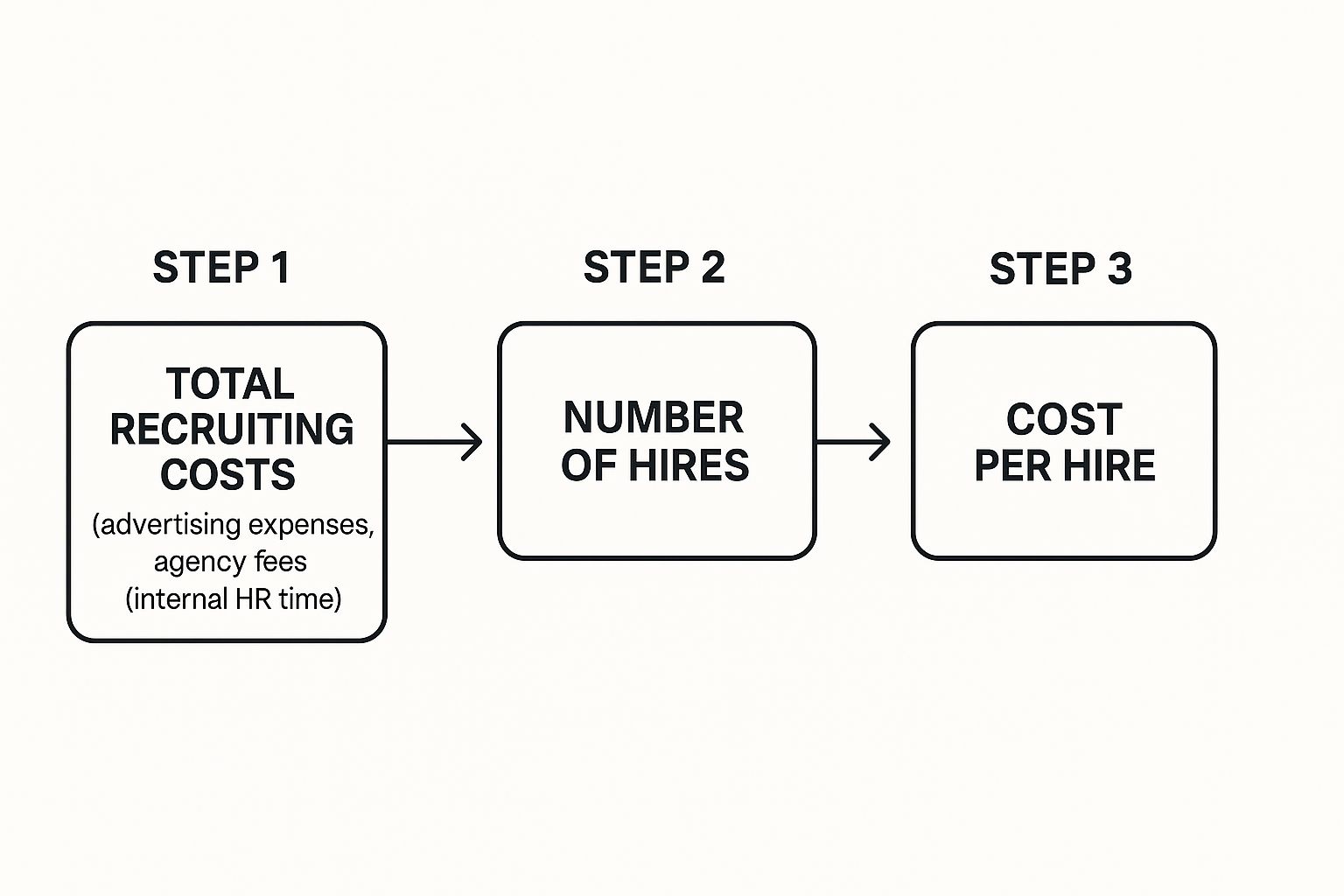How to Calculate Cost Per Hire: UK Guide to Recruitment Costs
- Talent People

- Jul 2, 2025
- 13 min read
Before we get into the nitty-gritty of formulas, let's talk about why this matters so much. Tracking your cost per hire isn't just another box-ticking exercise for the HR department. Honestly, it's one of the most important strategic moves you can make, directly influencing your company's profitability and growth. That one number tells a powerful story about how efficiently you're bringing people on board.
Why Tracking Cost Per Hire Matters

When you have a solid handle on your cost per hire, you get a crystal-clear financial snapshot of your recruitment. It stops being a vague "cost centre" and starts being seen as the strategic asset it truly is. Knowing exactly how much it costs to find and onboard new talent empowers you to make smarter, data-driven decisions that genuinely support your business goals.
And this isn't just about slashing budgets. It’s about spending wisely to get the best possible return on your investment. A detailed calculation helps you justify your team's budget, allocate resources where they'll have the most impact, and prove the value of what you do to the leadership team.
From Cost Centre to Strategic Partner
Think of it this way: if you notice your cost per hire is consistently high for a specific team, it’s a massive red flag. It could point to all sorts of underlying problems. Maybe the job descriptions are confusing, your interview process is dragging on forever, or you’re leaning too heavily on expensive agencies for roles you could fill yourselves.
I once worked with a tech start-up that saw their cost per hire for software developers was nearly 30% higher than the industry average. Once we dug into the data, it was obvious—they were pouring a fortune into agency fees. That realisation sparked a complete shift in their approach. They decided to:
Focus on building a much stronger employer brand to pull in great applicants organically.
Launch a proper employee referral programme with incentives that people actually wanted.
Invest in more affordable sourcing tools, like niche job boards for developers.
The result? In just six months, they brought their cost per hire way down and, crucially, found that the quality of candidates they were getting had improved. You can read more about these kinds of ideas in our guide on top recruitment strategies for high-growth industries. It’s a perfect example of how one metric can kickstart a major strategic overhaul.
Your cost per hire is more than just a number—it’s a diagnostic tool. It reveals the health of your talent acquisition process and points you directly to areas needing improvement.
The True Financial Impact of a New Hire
The money you spend goes way beyond just posting a job advert. When you start adding everything up, the true cost can be eye-watering. For example, some projections for 2025 suggest that for a role with a fairly average UK salary of £27,600, the total cost in the first year can soar to £62,890. That staggering figure includes everything from agency fees and employer National Insurance to the benefits package.
By keeping a close eye on this metric, you can stop these costs from spiralling. It lets you shift from a reactive, "we need someone now!" hiring panic to a proactive, strategic plan. This ensures every pound you spend on recruitment adds real value and supports the long-term, sustainable growth of the business.
Understanding The Cost Per Hire Formula

Alright, we’ve talked about why cost per hire is such a critical metric. Now, let’s get our hands dirty and figure out how to actually calculate it.
At its core, working out your cost per hire is surprisingly straightforward. The most common formula cuts through the noise and turns what feels like a complicated financial puzzle into a simple, powerful equation. Think of it less as a maths test and more as a way to understand the real story your recruitment numbers are telling.
The Core Equation
The standard formula for cost per hire just needs two main ingredients.
(Total Internal Costs + Total External Costs) / Total Number of Hires = Cost Per Hire
This isn't just a jumble of business terms. It’s a logical map of your entire recruitment investment over a set period. You add up every pound spent—both inside and outside the company—then divide that total by the number of people you successfully brought on board. What you’re left with is a clear, average cost for each new employee.
A Practical Example
Let's see how this plays out in the real world. Imagine a small tech firm in the UK that’s scaling up its development team.
Over the last financial quarter, they hired five new developers. To work out their cost per hire, they first need to gather all their expenses.
Internal Costs: This would include things like a portion of their HR manager’s salary (the time they spent on recruitment), any referral bonuses paid out to current staff, and the subscription fee for their Applicant Tracking System (ATS).
External Costs: These are often more direct. Think fees for posting jobs on specialist tech sites, payments to a recruitment agency for that one hard-to-fill senior role, and the cost of running background checks.
To get a precise figure, UK companies often follow the standard calculation. For instance, say a business spends £15,000 on internal recruitment efforts and another £25,000 on external agencies and advertising in a year. If they hired 10 employees in that time, their calculation would be:
(£15,000 + £25,000) / 10 = £4,000 per hire.
Once you have this final number, you can start asking important questions. Is it too high? Maybe it’s time to review those agency fees. Is it lower than expected? Perhaps that investment in your employer brand is really paying off. This simple calculation is the first step towards a smarter recruitment process, a key part of any strong talent acquisition strategy.
Uncovering Your Total Recruitment Costs
To really get a grip on your cost per hire, you need to put on your detective hat. The accuracy of this whole exercise boils down to one thing: how well you can track down every single expense tied to your hiring process. It's not just about the obvious invoices from agencies; it’s about digging into the hidden costs that often get missed.
A genuinely useful calculation includes both the money you spend externally and the internal resources you pour into the effort. So many businesses I see only track the direct spends like job ad fees, but that’s barely scratching the surface. To get the full story, you need to account for everything.
This image gives you a quick visual of how all the pieces fit together.

As you can see, the basic formula is straightforward: add up all your costs, then divide that total by the number of people you hired. The real work is in finding that "total costs" figure.
To make sure you don't miss anything, it's helpful to categorise your spending. Here’s a checklist you can use to identify and track every potential cost, separating the money you spend outside the business from the resources you use inside.
Internal vs External Recruitment Costs Checklist
Cost Category | Example Expenses | Notes |
|---|---|---|
External Agency Fees | Commissions to recruitment agencies, headhunter retainers. | This is often the largest single external cost for senior or specialised roles. |
Job Advertising | Postings on LinkedIn, Indeed, industry-specific job boards. | Don't forget sponsored posts or "pay-per-click" campaign costs. |
Candidate Screening | Third-party background checks, reference verification services. | Factor in any costs for skills testing or psychometric assessment platforms. |
Recruitment Events | Job fair stand hire, travel costs, marketing materials, sponsorships. | Remember the small things, like branded giveaways and printed collateral. |
Technology & Software | Subscriptions for your Applicant Tracking System (ATS), HRIS, video interview tools. | Prorate annual subscriptions to get a monthly or quarterly cost. |
Employer Branding | Costs for career page development, recruitment videos, paid social media campaigns. | This is an investment in attracting future talent, and a portion belongs here. |
Employee Time | Salaries for recruiters, hiring managers, and interviewers. | Calculate the hourly cost of each person and multiply by the hours they spend on hiring. |
Employee Incentives | Payouts for your employee referral bonus scheme. | A direct cost that's easy to track but often gets categorised incorrectly. |
Candidate Expenses | Reimbursing travel, accommodation, or meals for interviewees. | Crucial for attracting non-local candidates but can add up quickly. |
Using a checklist like this ensures you have a consistent and thorough approach every time you calculate your cost per hire. It takes the guesswork out of the process.
Nailing Down Your External Costs
Let’s start with the easy part: external costs. These are the tangible, out-of-pocket expenses you pay to other companies and services to help you hire. You’ll have an invoice or a receipt for pretty much all of them.
Think about things like:
Recruitment agency commission for sourcing that hard-to-find developer.
Fees for posting job ads on various online boards.
Payments to a third-party service for conducting background and reference checks.
Costs for a stand at a university careers fair, including travel and materials.
Reimbursing a candidate's train fare so they can attend a final-stage, in-person interview.
Gathering these numbers is usually quite simple. A quick chat with your finance department or a look through your accounting software should give you what you need.
Accounting for Your Internal Costs
Now for the tricky part, and where most companies get it wrong. Internal costs are the value of the time and resources your own team dedicates to hiring. These expenses are just as real as a recruitment agency's invoice, even though you don't write a specific cheque for them.
The biggest mistake people make when calculating cost per hire is ignoring the value of their team's time. If a department head spends 15 hours interviewing candidates for one role, that's a significant, tangible cost to the business.
To properly capture these hidden figures, you absolutely must factor in:
Your recruitment team's salaries and benefits—specifically, the portion of their time spent on active hiring.
Time spent by hiring managers and interviewers who aren't in HR. You need to calculate the cost of their time spent screening CVs, preparing questions, and sitting in interviews. This is a huge, and commonly overlooked, expense.
Referral bonuses you pay to your existing staff when they successfully recommend someone who gets hired.
Subscription fees for your hiring-related software, like your ATS.
By meticulously tracking both internal and external costs, you get a complete and honest picture of what it really takes to bring someone new into your business. This comprehensive view is the only way to arrive at a cost per hire metric that’s actually meaningful and helps you make smarter decisions.
A Real-World Cost Per Hire Example
Right, let's get practical. Theory is great, but seeing the numbers in action is what really makes the cost per hire formula click. Let's walk through a scenario together.
Imagine a growing marketing agency based in Manchester. It’s been a busy first quarter, and they’ve successfully hired four new people to keep up with client demand. To get a real sense of their recruitment spend for Q1, they need to gather all the relevant costs.
First, Let's Tally the External Costs
These are often the easiest to track – they’re the direct bills and invoices paid to other companies. It’s the money that has clearly left the building.
For this agency, the external spend looked like this:
Recruitment Agency Fee: They needed a specialist to find a senior Digital Strategist. The agency charged 20% of the £60,000 starting salary, which comes to a chunky £12,000.
Job Adverts: For the other three roles, they ran targeted campaigns on LinkedIn, spending a total of £950.
Background Checks: Standard procedure for all new starters. They used a service that charged £50 per person, totalling £200 for the four hires.
When you add those up, you get a clear picture of the external investment.
Total External Costs = £12,000 + £950 + £200 = £13,150
Next, Let's Factor in the Internal Costs
This is where many companies trip up. It’s tempting to ignore internal time and resources, but these costs are just as real and can be surprisingly high.
The Manchester agency has a part-time internal recruiter. She works 20 hours a week and her time costs the business £20 per hour. Over the 13-week quarter, her total salary cost was £5,200. After a quick chat, she estimated that about 75% of her time was spent on activities directly related to these four hires.
Recruiter's Time: £5,200 x 0.75 = £3,900
Then there’s the hiring managers' time – a cost that’s almost always overlooked. The agency calculated that, across all four roles, managers spent a combined 60 hours sifting through CVs, preparing for, and sitting in interviews. With an average hourly cost of £35, that time adds up.
Hiring Managers' Time: 60 hours x £35/hour = £2,100
Finally, let's not forget the referral bonuses. Two of the hires came from recommendations by current staff, who each received a £500 bonus as a thank you.
Referral Bonuses: 2 x £500 = £1,000
Now we have a much more honest view of the true internal cost.
Total Internal Costs = £3,900 + £2,100 + £1,000 = £7,000
Putting It All Together for the Final Number
We’ve done the hard work. Now we just need to plug our numbers into the simple cost per hire formula.
(Total Internal Costs + Total External Costs) / Total Number of Hires = Cost Per Hire
Let's do the maths for our Manchester agency:
Total Recruitment Costs: £13,150 (External) + £7,000 (Internal) = £20,150
Total Number of Hires: 4
The final calculation is straightforward:
£20,150 / 4 = £5,037.50
So, for Q1, the agency's average cost to bring a new person onto the team was £5,037.50. This isn't just a number; it's a powerful metric. They can now use this as a benchmark to track their efficiency, make smarter decisions about using agencies versus advertising, and see where they can improve their hiring process next quarter.
Using Data to Sharpen Your Hiring Strategy

So, you've calculated your cost per hire. That's a great first step, but the number on its own is just that—a number. The real magic happens when you start using that data to ask smarter questions. It’s how you shift recruitment from being seen as a necessary expense to a strategic partner that drives business growth.
Once you have a reliable cost per hire figure, it becomes a powerful diagnostic tool. You can finally start digging into what’s working, what isn't, and where the hidden opportunities are.
How Do You Stack Up? Benchmarking Your Performance
To get a real feel for whether your cost per hire is good, bad, or just average, you need a point of comparison. Benchmarking against industry standards is the best way to get that context.
According to the Chartered Institute of Personnel and Development (CIPD), the average cost per hire in the UK hovers around £6,125 for standard recruitment activities. And that's before you even factor in things like onboarding and training. You can learn more about the true cost of hiring an employee from Payfit.
If your figure is coming in much higher than the average, it’s a clear sign that you need to take a closer look at your process.
Dig Into Your Sourcing Channels
Let's be honest, not all hiring channels are created equal. Your own data will tell you this story better than anyone. Break down your cost per hire by the source of the candidate. I've seen it time and time again with clients; the results can be eye-opening.
You'll likely find patterns like these:
Recruitment agencies: Almost always the highest cost per hire, but they can be invaluable for finding niche specialists on a tight deadline.
LinkedIn advertising: A solid mid-range option that gives you broad reach across different professional levels.
Employee referral programme: Often boasts the lowest cost per hire and, in my experience, frequently delivers the highest quality candidates who stick around longer.
Analysing this helps you see the true return on investment (ROI) for each channel. That expensive agency might be a non-negotiable for a critical senior role, but you might also realise your referral scheme is a low-cost goldmine you haven't been promoting enough.
A cost per hire report should never be a document that just gathers dust on a digital shelf. Think of it as a live tool for allocating your budget where it will have the most impact.
By getting into the weeds, you can make genuinely informed decisions. Maybe you need to pump more resources into your referral programme or shift budget away from a generic job board towards a highly targeted social media campaign. This is how you achieve smarter hiring with recruitment data analysis. You’re turning a simple metric into a powerful lever, ensuring every pound you spend is building the best possible team.
Of course. Here is the rewritten section, designed to sound like it was written by an experienced human expert.
Answering the Tricky Questions About Cost Per Hire
Once you start applying the cost-per-hire formula to your own recruitment data, the theory quickly meets reality. That’s when the tricky "what if" questions pop up. It’s one thing to have a neat formula on a spreadsheet; it’s another to deal with the messy, real-world situations that don't fit into clean boxes.
Let’s walk through some of the most common questions I hear from HR and talent leaders. Getting these details right is about more than just numbers; it’s about making sure your metric is consistent and genuinely useful for tracking progress and comparing against industry benchmarks.
What If a Hire Falls Through?
Ah, the one that everyone dreads. You’ve invested weeks of work, the offer has been signed, and then… radio silence. Or worse, they start and leave within the first month. Do you still count the costs for that hire?
Yes, you absolutely do. It’s a bitter pill to swallow, but every penny and every hour spent on that failed attempt is a real cost to the business. It’s a sunk cost of recruitment for that period.
By including it in your total expenses, your cost per hire will go up. This isn't a failure of measurement; it's the metric doing its job perfectly. It’s shining a spotlight on an inefficiency or a problem in your process—be it a weak final-stage experience or a misalignment on expectations. That's exactly the kind of insight you need to drive improvements.
Should Onboarding Costs Be Included?
This is a classic point of debate, but my firm advice is to keep them separate. Your cost per hire metric should stop the clock the moment the candidate signs their contract.
Think of them as two distinct, but connected, parts of a journey:
Cost Per Hire tells you how efficiently you can attract and secure talent.
Cost of Onboarding measures the investment needed to get that talent fully productive.
Blurring the two creates a muddy picture. You could have a hugely expensive recruitment process masked by a brilliantly lean onboarding programme, or the other way around. Keeping them separate gives you two clear dials to adjust.
It's far better to have two clean metrics you can act on than one confusing number that hides the real story. This clarity is key to optimising each stage of the new employee’s journey.
What Is a Good Cost Per Hire?
This is the question I get asked most, and the honest, experienced answer is always: it depends. There is no single magic number. What’s considered “good” is entirely contextual.
Several big factors will shape what a reasonable cost per hire looks like for you:
Industry: Finding a specialist software developer for a fintech company is a different ball game entirely from hiring a customer service agent.
Role Seniority: An executive search can run into the tens of thousands and be perfectly justifiable. A graduate role should be a tiny fraction of that.
Location: Recruiting in a competitive, high-cost city like London or Manchester will naturally demand a bigger budget than in a smaller town.
Instead of hunting for a universal number to beat, focus on your own data. The real goal is to track your cost per hire over time. Are you seeing a downward trend for similar roles? Or are you holding costs steady while demonstrably improving the quality of the people you bring in? That's the mark of a successful strategy.
At Talent People, we work with high-growth companies to find the answers to these tough questions. We help build recruitment strategies that are both efficient and effective, especially for scaling teams in complex markets like energy and technology. Find out how our agile, project-based hiring solutions can help you at https://talentpeople.co.

Comments